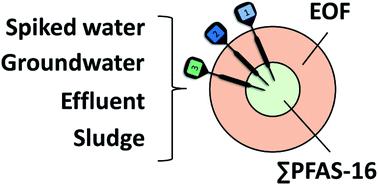当前位置:
X-MOL 学术
›
Environ. Sci.: Processes Impacts
›
论文详情
Our official English website, www.x-mol.net, welcomes your
feedback! (Note: you will need to create a separate account there.)
Can determination of extractable organofluorine (EOF) be standardized? First interlaboratory comparisons of EOF and fluorine mass balance in sludge and water matrices
Environmental Science: Processes & Impacts ( IF 4.3 ) Pub Date : 2021-09-10 , DOI: 10.1039/d1em00224d Anna Kärrman 1 , Leo W Y Yeung 1 , Kyra M Spaan 2 , Frank Thomas Lange 3 , Minh Anh Nguyen 4 , Merle Plassmann 2 , Cynthia A de Wit 2 , Marco Scheurer 3 , Raed Awad 4 , Jonathan P Benskin 2
Environmental Science: Processes & Impacts ( IF 4.3 ) Pub Date : 2021-09-10 , DOI: 10.1039/d1em00224d Anna Kärrman 1 , Leo W Y Yeung 1 , Kyra M Spaan 2 , Frank Thomas Lange 3 , Minh Anh Nguyen 4 , Merle Plassmann 2 , Cynthia A de Wit 2 , Marco Scheurer 3 , Raed Awad 4 , Jonathan P Benskin 2
Affiliation

|
The high proportion of unidentified extractable organofluorine (EOF) observed globally in humans and the environment indicates widespread occurrence of unknown per- and polyfluoroalkyl substances (PFAS). However, efforts to standardize or assess the reproducibility of EOF methods are currently lacking. Here we present the first EOF interlaboratory comparison in water and sludge. Three participants (four organizations) analyzed unfortified and PFAS-fortified ultrapure water, two unfortified groundwater samples, unfortified wastewater treatment plant effluent and sludge, and an unfortified groundwater extract. Participants adopted common sample handling strategies and target lists for EOF mass balance but used in-house combustion ion-chromatography (CIC) and liquid chromatography-tandem mass spectrometry (LC-MS/MS) methods. EOF accuracy ranged from 85–101% and 76–109% for the 60 and 334 ng L−1 fluorine (F) – fortified water samples, respectively, with between-laboratory variation of 9–19%, and within-laboratory variation of 3–27%. In unfortified sludge and aqueous samples, between-laboratory variation ranged from 21–37%. The contribution from sum concentrations of 16 individual PFAS (∑PFAS-16) to EOF ranged from 2.2–60% but extended analysis showed that other targets were prevalent, in particular ultra-short-chain perfluoroalkyl acids (e.g. trifluoroacetic acid) in aqueous samples and perfluoroalkyl acid-precursors (e.g. polyfluoroalkyl phosphate diesters) in sludge. The EOF-CIC method demonstrated promising accuracy, robustness and reporting limits but poor extraction efficiency was observed for some targets (e.g. trifluoroacetic acid).
中文翻译:

可萃取有机氟 (EOF) 的测定能否标准化?污泥和水基质中 EOF 和氟质量平衡的首次实验室间比较
在全球范围内在人类和环境中观察到的不明可提取有机氟 (EOF) 的比例很高,这表明未知的全氟和多氟烷基物质 (PFAS) 广泛存在。然而,目前缺乏标准化或评估 EOF 方法重现性的努力。在这里,我们展示了水和污泥中的第一个 EOF 实验室间比较。三名参与者(四个组织)分析了未强化和 PFAS 强化的超纯水、两个未强化的地下水样品、未强化的污水处理厂流出物和污泥以及未强化的地下水提取物。参与者采用常见的样品处理策略和 EOF 质量平衡的目标列表,但使用内部燃烧离子色谱 (CIC) 和液相色谱-串联质谱 (LC-MS/MS) 方法。-1氟 (F) – 分别为强化水样,实验室间差异为 9–19%,实验室内差异为 3–27%。在未强化的污泥和水性样品中,实验室之间的差异范围为 21-37%。16 种个体 PFAS (∑PFAS-16) 的总浓度对 EOF 的贡献范围为 2.2-60%,但扩展分析表明其他目标很普遍,特别是水性样品中的超短链全氟烷基酸(例如三氟乙酸)和污泥中的全氟烷基酸前体(例如多氟烷基磷酸二酯)。EOF-CIC 方法显示出有希望的准确度、稳健性和报告限,但观察到某些目标(例如 三氟乙酸)。
更新日期:2021-09-21
中文翻译:

可萃取有机氟 (EOF) 的测定能否标准化?污泥和水基质中 EOF 和氟质量平衡的首次实验室间比较
在全球范围内在人类和环境中观察到的不明可提取有机氟 (EOF) 的比例很高,这表明未知的全氟和多氟烷基物质 (PFAS) 广泛存在。然而,目前缺乏标准化或评估 EOF 方法重现性的努力。在这里,我们展示了水和污泥中的第一个 EOF 实验室间比较。三名参与者(四个组织)分析了未强化和 PFAS 强化的超纯水、两个未强化的地下水样品、未强化的污水处理厂流出物和污泥以及未强化的地下水提取物。参与者采用常见的样品处理策略和 EOF 质量平衡的目标列表,但使用内部燃烧离子色谱 (CIC) 和液相色谱-串联质谱 (LC-MS/MS) 方法。-1氟 (F) – 分别为强化水样,实验室间差异为 9–19%,实验室内差异为 3–27%。在未强化的污泥和水性样品中,实验室之间的差异范围为 21-37%。16 种个体 PFAS (∑PFAS-16) 的总浓度对 EOF 的贡献范围为 2.2-60%,但扩展分析表明其他目标很普遍,特别是水性样品中的超短链全氟烷基酸(例如三氟乙酸)和污泥中的全氟烷基酸前体(例如多氟烷基磷酸二酯)。EOF-CIC 方法显示出有希望的准确度、稳健性和报告限,但观察到某些目标(例如 三氟乙酸)。











































 京公网安备 11010802027423号
京公网安备 11010802027423号